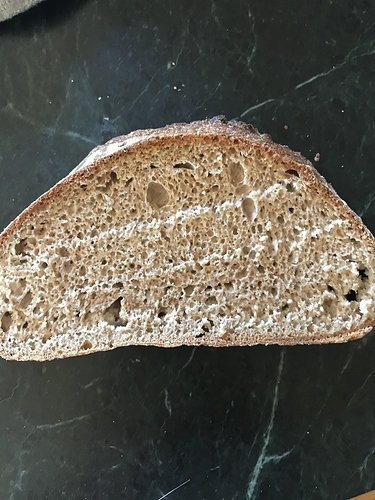I bake every couple of days and in hot spells, I don’t want to have to refresh my starter every 4 hours nor do I want to put it in the fridge only to have to spend days getting back up to speed. I’m thinking of putting one of those ice alternatives (what they’re called is escaping me right now-bricks? blocks?) in a cooler and changing that whenever it gets warm. Does anyone have a strategy or devised some kind of equipment for keeping their starter from getting too warm?
Build up some starter, enough for however much you need for a few days, when mature refrigerate. Then take some off to use in your dough when ready to bake. No need to go crazy on the refreshments every single time. If you use it within a few days it’ll be fine. In fact if you use the starter within 2 weeks it’ll be fine. Or you can even push it for longer. However when using a substantial amount of starter to fresh flour ratio in your dough I’d stick to a few days. Reason being the longer its left the more broken down the starter is which will compromise the structure of the dough and if left for too long it will impart off flavours. But certainly within a week it’ll be fine.
Thanks Abe. I’ll give it a try. Some teachers put a lot of emphasis on the condition of the starter–that it’s bubbly and active, even if you’re making a levain. They say if it’s been in the fridge, it’s going to be sleepy when it comes out. You seem to be saying that doesn’t matter.
There are rules we follow when learning how to use a sourdough starter. One learns the rules before knowing which rules may be broken. Why all this emphasis on feeding the starter, even a few times, until very bubbly and that’s even before going onto the levain?
1: its been in the fridge for a long while and may be sluggish.
2: if using a high percentage of starter, and its been in the fridge for a while, it might give off flavours not wanted in a bread.
3: its just good practice.
But tell me… If when feeding a starter, after its been in the fridge for while, it bubbles up then why can’t it leaven bread? Yes, it might be a bit slower (but not much if it has been fed and matured within a few days) but give it the time it needs which is the golden rule of baking anyway! Because its very warm where you live you might benefit from it being slower.
Certainly if its been more then a week and you’re going for a high percentage of starter it would be a good idea to feed it before moving onto the dough stage. However if its within a week there’s no issue preparing a batch for the week ahead and storing it in the fridge to use when needed. If its two weeks then still fine but to avoid off flavours go for less starter and give it more time. If its longer then follow the golden rule of feeding first.
Great thoughts. Thanks!
Here’s a fun loaf made with 5g starter (ripe)… that’s 1% inoculation 

Just recently I used a cooler for a dough that I wanted in a space warmer than a fridge but cooler than room temp (it was hot that day). It worked great. With one of those blue ice “bricks”, in 7 hours the temperature in the cooler went from 52F to 55F which I thought was pretty good (I kept a thermometer inside). I then took that brick out and replaced it with a second one I had in the freezer. It depends on the size of the cooler I suppose. Mine was the size to hold about 2 gallon-size jugs of milk, with several inches to spare at the top.
Yes, that’s what I was thinking of trying. Appreciate the stats! Thanks!
Oh that’s a great idea! Maybe I should get a cooler!
Ok, I got a cooler. Kept the dough in it for the whole process - levain, autolyse (separate from levain), stretch and fold. Then overnight in the fridge. It’s a smaller loaf than I usually make, and I’m not very happy with the lack of oven spring, but it’s a big improvement from the over-fermented mess I was getting before. I’ll keep working on it.
It tastes pretty good. But something is off about the spring!
I think the scoring has a part to play in that. Can you post a crumb shot?
It’s not great. I used about 50% whole wheat. I was working fast to get away from the hot oven - so didn’t slash very mindfully.
For 50% wholegrain it looks very good. Nice even crumb. I think the scoring was the issue here causing it to split too much. Next time how about putting the dough into the banneton seam side down then when you turn it over the seam will be a natural scoring. Something to try.
Interesting idea! I’ve generally had better results so I’m sure there’s an answer. I’m just so happy to have the cooler now! No
More ruined dough! Thank so much.

